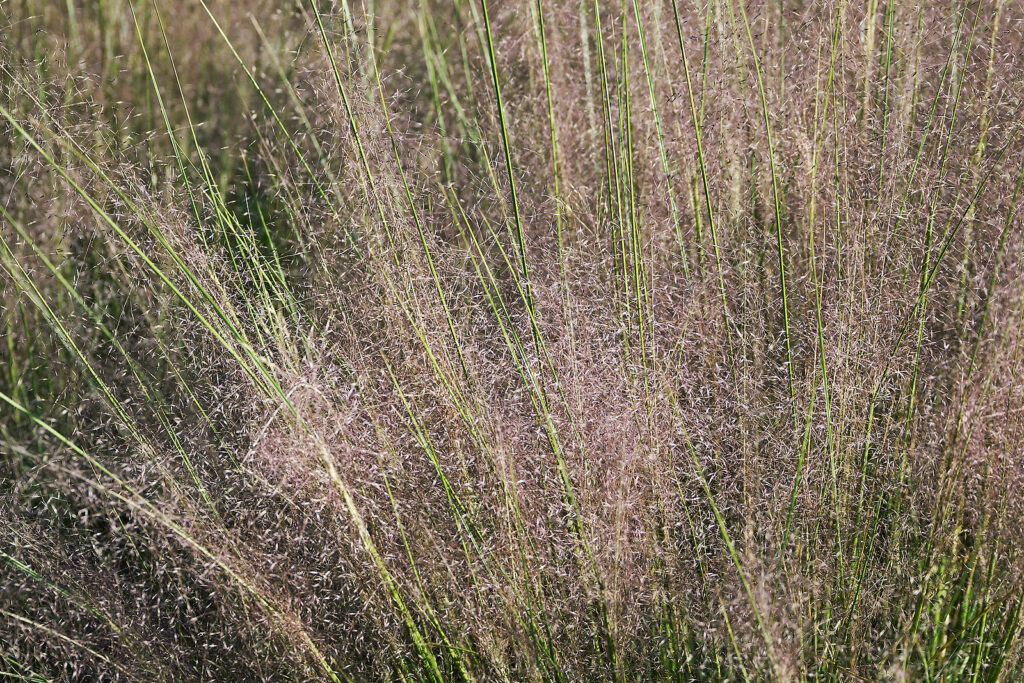Muhlenbergia is a perennial grass that grows from 1 to 3 feet or taller with fine-textured green to glaucous blue basal foliage topped by airy inflorescences some of which are pink, purple-red, or purple-gray. Muhlenbergia is commonly called deer grass.
Muhlenbergia grows easily in a variety of soil including sandy and gravelly soils. It requires little water to become established and is drought tolerant once established. Muhlenbergia grows large with supplemental water.
Like many other ornamental types of grass, Muhlenbergia stands out in late summer and autumn gardens. It can be included in borders or planted in groups where the sun catches the color of the foliage and flowers.
Muhlenbergia is native to the southwestern United States and parts of Mexico.
Get to know Muhlenbergia
- Plant type: Perennial grass
- Growing zones and range: Zones 7-10
- Hardiness: Hardy to Zone 7; evergreen in mild winters
- Height and width: 24 to 36 inches tall and wide
- Foliage: Long, light grey-green fine-textured foliage
- Flowers: Airyflowers stalks can be pink, purple-red, or purple-gray
- Bloom time: Late summer
- Uses: Ornamental groundcover
- Common name: Muhly, deer grass
- Botanical name: Muhlenbergia
- Family name: Poaceae
- Origin: Southwestern United States

Where to plant Muhlenbergia
- Plant Muhlenbergia in full sun or partial shade.
- Muhlenbergia will grow in most soil that are well drained.
- Muhlenbergia will grow in sandy and gravelly soils.
When to plant Muhlenbergia
- Set container grown Muhlenbergia or divisions in the garden in spring.
Planting and spacing Muhlenbergia
- Space Muhlenbergia 24 to 36 inches apart.
How to water and feed Muhlenbergia
- Give Muhlenbergia moderate water until well-established. Established plants need little water.
- Fertilize Muhlenbergia with an all-purpose liquid fertilizer in late spring.
Muhlenbergia care
- Cut back plants in late winter for fresh, new growth in spring.
Muhlenbergia pests and diseases
- Crown and root rot can occur in wet soil.
Muhlenbergia propagation
- Sow seed in autumn or spring.
- Clumps can be divided in spring.
Muhlenbergia varieties to grow
- Muhlenbergia capillaris, pink muhly. Grows 3 to high and 6 feet wide; dark green foliage; airy plume of feathery reddish flowers.
- M. dubia, pine muhly. Grows 2 to 3 feet tall and wide; upright fine-textured leaves; creamy flower spikes in summer and fall.
- M. dumosa, bamboo muhly. Grows 3 to 6 feet tall and wide; resembles bamboo; bright green leaves; flower clusters in spring not noticeable.
- M. emersleyi, bull grass. Grows 1.5 feet high and 3 feet wide; purplish or reddish flower clusters rise above foliage.
- M. lindheimeri. Soft, arching, blue-green leaves grow to 5 feet high; amber flower spires appear above foliage. Cultivar ‘Autumn Glow’ has yellow flowers in fall.
- M. porteri, bush muhly. Grows to 3 feet tall and wide; blue-green stems; profuse small, pinkish purple seed heads in late summer.
- M. pubescens, soft blue Mexican muhly. Downy, blyue-green foliage to 1 foot high and 2 feet wide; light blue aging to amber flower spikes.
- M. rigens, deer grass. Bright green leaves form dense, tight clumps; grows to 4 feet tall and wide; slender yellow or purplish flowers spikes in autumn.
- M. rigida, purple muhly. Green clump to 2 feet high; 3 foot spikes of brownish purple to deep purple flowers in late summer.















